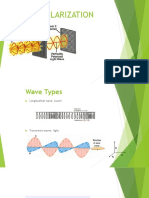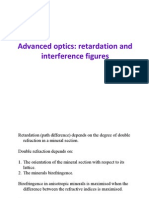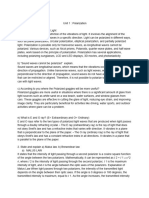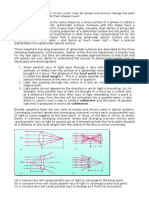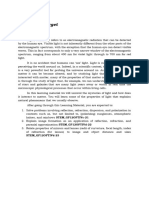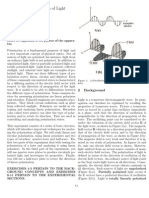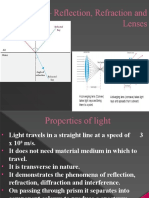Professional Documents
Culture Documents
Double Refraction Brewster Law
Uploaded by
Usama Hafeez0 ratings0% found this document useful (0 votes)
29 views2 pagesDouble refraction is an optical property where a ray of light entering an anisotropic medium splits into two rays that travel in different directions - an ordinary ray that passes through unchanged and an extraordinary ray that is refracted at an angle. This can be observed using a pencil mark on paper covered by glass, which shows one image, versus calcite crystal, which orients to show two separate marks. The phenomenon occurs as light enters the crystal face, splitting the incident ray into the ordinary and extraordinary rays.
Original Description:
Copyright
© © All Rights Reserved
Available Formats
DOCX, PDF, TXT or read online from Scribd
Share this document
Did you find this document useful?
Is this content inappropriate?
Report this DocumentDouble refraction is an optical property where a ray of light entering an anisotropic medium splits into two rays that travel in different directions - an ordinary ray that passes through unchanged and an extraordinary ray that is refracted at an angle. This can be observed using a pencil mark on paper covered by glass, which shows one image, versus calcite crystal, which orients to show two separate marks. The phenomenon occurs as light enters the crystal face, splitting the incident ray into the ordinary and extraordinary rays.
Copyright:
© All Rights Reserved
Available Formats
Download as DOCX, PDF, TXT or read online from Scribd
0 ratings0% found this document useful (0 votes)
29 views2 pagesDouble Refraction Brewster Law
Uploaded by
Usama HafeezDouble refraction is an optical property where a ray of light entering an anisotropic medium splits into two rays that travel in different directions - an ordinary ray that passes through unchanged and an extraordinary ray that is refracted at an angle. This can be observed using a pencil mark on paper covered by glass, which shows one image, versus calcite crystal, which orients to show two separate marks. The phenomenon occurs as light enters the crystal face, splitting the incident ray into the ordinary and extraordinary rays.
Copyright:
© All Rights Reserved
Available Formats
Download as DOCX, PDF, TXT or read online from Scribd
You are on page 1of 2
Double refraction
Double refraction, also called birefringence, an optical property in
which a single ray of un polarized light entering an anisotropic
medium is split into two rays, each traveling in a different direction.
One ray (called the extraordinary ray) is bent, or refracted, at an angle
as it travels through the medium; the other ray (called the ordinary
ray) passes through the medium unchanged.
Double refraction can be observed by comparing two
materials, glass and calcite. If a pencil mark is drawn upon a
sheet of paper and then covered with a piece of glass, only
one image will be seen; but if the same paper is covered with
a piece of calcite, and the crystal is oriented in a specific
direction, then two marks will become visible.
The Figure shows the phenomenon of double refraction
through a calcite crystal. An incident ray is seen to split into
the ordinary ray CO and the extraordinary ray CE upon
entering the crystal face at C. If the incident ray enters the
crystal along the direction of its optic axis, however, the light
ray will not become divided.
Anisotropic material changes its properties in different
directions.
You might also like
- BirefringenceDocument2 pagesBirefringencemujeeb.abdullah2830No ratings yet
- Polarised Unpolarised LightDocument17 pagesPolarised Unpolarised LightNaman MalhanNo ratings yet
- Naked Eye. Such Type of Object Are Called Microscopic Object. and The Science of Investigating ofDocument3 pagesNaked Eye. Such Type of Object Are Called Microscopic Object. and The Science of Investigating ofkamalNo ratings yet
- PolarizationDocument43 pagesPolarizationAriendam dwivediNo ratings yet
- PolarizationDocument7 pagesPolarizationrajesh.v.v.kNo ratings yet
- Polarisation Revision NotesDocument15 pagesPolarisation Revision NotesS M NashimuddinNo ratings yet
- Advanced Optics: Retardation and P Interference FiguresDocument22 pagesAdvanced Optics: Retardation and P Interference FiguresUtsab KunduNo ratings yet
- Advanced Optics: Retardation and P Interference FiguresDocument22 pagesAdvanced Optics: Retardation and P Interference FiguresPritam GoswamiNo ratings yet
- PolarizationDocument12 pagesPolarizationshovon sarderNo ratings yet
- BirefringenceDocument2 pagesBirefringencebhanu prakashNo ratings yet
- Physics Question BankDocument60 pagesPhysics Question BankUnknown ManNo ratings yet
- BirefringenceDocument9 pagesBirefringenceDoug Bank100% (1)
- PH 201 Optics & Lasers: Lecture - Polarization - 3Document29 pagesPH 201 Optics & Lasers: Lecture - Polarization - 3Selvi RNo ratings yet
- 8 PolarizationDocument42 pages8 PolarizationLegend ProNo ratings yet
- PolarizationDocument89 pagesPolarizationadisabbella2502No ratings yet
- Polarisation of LightDocument8 pagesPolarisation of LightVenu Gopal100% (1)
- Refraction of Light Made by Ritam Saha, Julien Day SchoolDocument84 pagesRefraction of Light Made by Ritam Saha, Julien Day SchoolMunmun SahaNo ratings yet
- Nicol PrismDocument4 pagesNicol PrismDr. Pradeep Kumar SharmaNo ratings yet
- PolarizationDocument31 pagesPolarizationmames infinteNo ratings yet
- BirefringenceDocument10 pagesBirefringencenetname1No ratings yet
- Reflection For OpticsDocument1 pageReflection For OpticsI N Z A N I T YNo ratings yet
- Question 8KdDocument5 pagesQuestion 8KdShihabsirNo ratings yet
- Physics Behind Double Refraction and BirefringenceDocument2 pagesPhysics Behind Double Refraction and BirefringenceViratNo ratings yet
- Polarization AND Huygen'S Theory of Double Refraction: Anuroop Ashok Ist Yr. B TechDocument35 pagesPolarization AND Huygen'S Theory of Double Refraction: Anuroop Ashok Ist Yr. B TechChandra sekharNo ratings yet
- Physics 2 Week4Document19 pagesPhysics 2 Week4basurahangyujNo ratings yet
- Optics 3Document3 pagesOptics 3Ankit Kumar AJNo ratings yet
- Lecture Phase Matching-Sept 27 2010Document9 pagesLecture Phase Matching-Sept 27 2010regio122No ratings yet
- Optics10 PhysicsDocument7 pagesOptics10 PhysicsTapas BanerjeeNo ratings yet
- Retarder 2Document9 pagesRetarder 2James FlawrenceNo ratings yet
- Refraction by LensesDocument5 pagesRefraction by LensesJanis Micaela EsmasNo ratings yet
- Qualitative Description About The Various PolarizationsDocument38 pagesQualitative Description About The Various PolarizationsAdit WicaksonoNo ratings yet
- Physical PrinciplesDocument21 pagesPhysical PrinciplesLeo CerenoNo ratings yet
- Science ReviewerDocument5 pagesScience Reviewerarieannie katlyNo ratings yet
- Polarization of LightDocument4 pagesPolarization of LightŠimon TruchlikNo ratings yet
- Malabanan Matthew Sa3 Part C Phyla1Document6 pagesMalabanan Matthew Sa3 Part C Phyla1Matt MalabananNo ratings yet
- Lab 8: Polarization of Light: Figure 1: (A) Oscillation of E Vector, (B) An Electromagnetic FieldDocument10 pagesLab 8: Polarization of Light: Figure 1: (A) Oscillation of E Vector, (B) An Electromagnetic Fieldpankajpnd1No ratings yet
- Exp7 Calcite CrystalDocument9 pagesExp7 Calcite Crystalctremblaylcsd150No ratings yet
- Verify MalusDocument5 pagesVerify MalusReema KhanNo ratings yet
- Specular Diffuse:, or in Other Words, The Angle of Incidence Equals The Angle of ReflectionDocument4 pagesSpecular Diffuse:, or in Other Words, The Angle of Incidence Equals The Angle of ReflectionMaui ShihtzuNo ratings yet
- Light Mirrors LensesDocument11 pagesLight Mirrors LensesMarjorie Rose TeodosioNo ratings yet
- A Practical Manual of the Collodion Process: Giving in Detail a Method For Producing Positive and Negative Pictures on Glass and PaperFrom EverandA Practical Manual of the Collodion Process: Giving in Detail a Method For Producing Positive and Negative Pictures on Glass and PaperNo ratings yet
- Petrological MicroscopeDocument2 pagesPetrological MicroscopeNand B. VidyaNo ratings yet
- Polarization of LightDocument4 pagesPolarization of LightMartina RybárikováNo ratings yet
- Grade 10 Science PointersDocument2 pagesGrade 10 Science PointersHendrix Antonni AmanteNo ratings yet
- Optics - Reflection, Refraction and LensesDocument46 pagesOptics - Reflection, Refraction and LensesBrianna Malcolm100% (1)
- What Is Polarization? 1Document7 pagesWhat Is Polarization? 1Shaswath SasiNo ratings yet
- Grade 10 Quarter 2 Module 3 - Qualitative CharacteristicsDocument14 pagesGrade 10 Quarter 2 Module 3 - Qualitative CharacteristicsAlljhon Dave Joshua MagnoNo ratings yet
- Ray Optics (Note 2020) 2Document39 pagesRay Optics (Note 2020) 2Y S BAMMANAL y sNo ratings yet
- Unit-I - Topic-PolarizationDocument12 pagesUnit-I - Topic-PolarizationMUSICAL MASTI RINGTONENo ratings yet
- Nicol PrismDocument3 pagesNicol PrismNil TaiiayNo ratings yet
- Stress OpticsDocument11 pagesStress Opticschantaiah100% (1)
- UNIT - III Polarization: By-Dr P M PatelDocument89 pagesUNIT - III Polarization: By-Dr P M PatelSuvankar ChakrabortyNo ratings yet
- Welcome To My ClassDocument35 pagesWelcome To My ClassSPECIFIED With SIMFLIFICATIONNo ratings yet
- Properties of LightDocument28 pagesProperties of LightAbdulhamid Abdulwaasi'No ratings yet
- Additional Notes - LightDocument10 pagesAdditional Notes - LightsidharthNo ratings yet
- Hour 3-4Document2 pagesHour 3-4EDGARDO RAUL ROQUE CHOQUENo ratings yet
- Opticsbasicsconcepts 170317181954Document189 pagesOpticsbasicsconcepts 170317181954MAHMOUD AL-SHAIBANINo ratings yet
- Propagation of LightDocument16 pagesPropagation of LightCiara ManangoNo ratings yet
- Physical OpticsDocument26 pagesPhysical OpticsMuhammad FajriNo ratings yet
- THE DIGITAL PAKISTAN POLICY, Vision and ExecutionDocument4 pagesTHE DIGITAL PAKISTAN POLICY, Vision and ExecutionUsama HafeezNo ratings yet
- Climate Change & Food SecuirtyDocument15 pagesClimate Change & Food SecuirtyUsama HafeezNo ratings yet
- Write A Précis of The Following Passage in About 120 Words and Suggest A Suitable TitleDocument5 pagesWrite A Précis of The Following Passage in About 120 Words and Suggest A Suitable TitleUsama HafeezNo ratings yet
- Band Theory of SolidsDocument5 pagesBand Theory of SolidsUsama HafeezNo ratings yet
- Lecture Note On Crystal Structures Solid State Physics: June 2015Document62 pagesLecture Note On Crystal Structures Solid State Physics: June 2015Usama HafeezNo ratings yet
- Resolution of VectorDocument3 pagesResolution of VectorUsama HafeezNo ratings yet
- Design and Fabrication of Vertical Axis Nature Inspired Wind TurbineDocument34 pagesDesign and Fabrication of Vertical Axis Nature Inspired Wind TurbineUsama HafeezNo ratings yet



